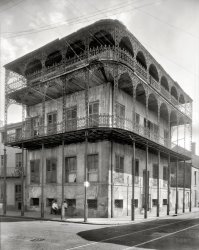
MAY CONTAIN NUTS

Search Shorpy
SHORPY ART

Framed or unframed, desk size to sofa size, printed by us in Arizona and Alabama since 2007. Explore now.
Join and Share
Ad-Free Shorpy
Shorpy is funded by you. Patreon contributors get an ad-free experience.
Learn more.

Recent comments
- Tough Guys
- Lost in Toyland
- And without gloves
- If I were a blindfolded time traveler
- Smoke Consumer Also Cooks
- Oh that stove!
- Possibly still there?
- What?!?
- $100 Reward
- Freeze Frame
- Texas Flyer wanted
- Just a Year Too Soon
- WWII -- Replacing men with women at the railroad crossing.
- Yes, Icing
- You kids drive me nuts!
- NOT An Easy Job
- I wonder
- Just add window boxes
- Icing Platform?
- Indiana Harbor Belt abides
- Freezing haze
- Corrections (for those who care)
- C&NW at Nelson
- Fallen Flags
- A dangerous job made worse
- Water Stop
- Passenger trains have right of way over freights?
- Coal
- Never ceases to amaze me.
- Still chuggin' (in model form)
Member Photos
The Shorpy
Print Emporium
Print Emporium
Search Shorpy
Search results -- 30 results per page
- Louisiana: 1937
- July 1937. "Louisiana Negress." View full size. Medium-format nitrate negative and ... love her hat and parasol, with her crisp pinner apron!
Louisiana: 1937 Another wonderful photo Dave. New screensaver...
Nice. Una foto preciosa.
Louisiana Woman I'd be hard pressed to name a favorite among Lange's work, ... Posted by Dave - 05/08/2013 - 11:12am -
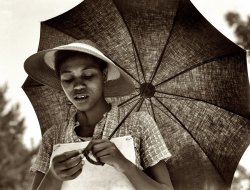
- Forest Brook: 1956
- ...
DaveB
Wonderful Grade school in Alexandria, Louisiana. Very familiar classrooms, with the good Nun up front to keep [or ... Posted by Dave - 02/14/2013 - 7:14am -
![Forest Brook: 1956 November 8, 1956. "Forest Brook Elementary School, Hauppauge, Long Island. Classroom and teacher." For those of a certain demographic, this may strike a chord. Large-format negative by Gottscho-Schleisner. View full size.
We never did that.I grew up in the suburbs around Akron, Ohio, and we never had a bomb drill or duck-and-cover drill ever. All of my peers that grew up in other places had those drills, which has led me to a couple of possible theories. One, that we had some sort of pacifists in our local administration that refused to take part in the Cold War(unlikely). Or two, that we were so close to potential industrial targets that there was simply no point in hoping for survival... Better to go out in the first flash.
[Never had them in my grade school years 1952-1960 in Larkspur, California, either, nor was I aware at the time that they were going on anywhere. -tterrace]
Lighting fixturesWe had very similar fixtures in my Elementary School about ten years after this, ours had a large bulb with the bottom painted silver sticking through the center though.
They were probably ancient even in 1966.
X marks the spotI'm not sure if it looked that way in 1956, but Forest Brook today has a strange shape, what you might get if Picasso or Dali had been asked to draw the letter X.
Hauppague today is a densely populated community, home to most of Suffolk County's government (though Riverhead is the actual county seat) and a huge industrial park, but back in 1956 it was on the frontier of suburbanization. I wouldn't be surprised if some of the students in this picture were the children of farmers.
You will not leave this house dressed like thatIt would be three years before I entered first grade about 20 miles west of Hauppauge. The New York City Board of Education had a much less relaxed dress code. Boys from first grade on had to wear ties. Jeans and sneakers were not permitted. On school assembly day everyone was required to wear a white shirt or blouse and the boys had to wear red ties. Of course by the time we were graduating from high school there were still strict dress standards, but they only applied to the teachers.
Smelementary SchoolThose wooden desks were washed and cleaned before classes three months ago, and the floors are waxed weekly.
All the girls are in skirts or dresses, and the boys are well groomed and always polite. After all, no one wants to get called down to the school office!
Plus, there's a great lineup of cars out the window, in case a little daydreaming is in order, but only for a few seconds at a time. By the way, you can smell today's newfangled hot lunch almost ready to serve, down the hall.
Let there be photonsMy elementary school (Horace Mann in Burbank, Calif.) had the same light fixtures, although we had four to a room. Each contained one ≈500 watt bulb; the bottom of the bulb was obscured by a silver coating. When a bulb was nearing the end of its service life, it would usually emit a high-pitched squeal. The teacher would then cycle the light switch off and on several times, killing the bulb and throttling the distracting squeal.
Reading MaterialMost of the children have notebooks, many children seem to have the Spell and Write workbook, and the young man in the lower left (just behind the girl in the foreground) has the Air Raid Instruction booklet on his desk.
My First Year of School1956 was my first year of school in Houston. Would have loved to have been able to wear blue jeans and shirt tails out but HISD rules at the time (and almost all the way through my HS years) said no blue jeans, no t-shirts, no shirt tails out for boys and skirts/dresses only for girls.
Hard to believe especially since the schools weren't air conditioned in HISD except for offices and a few other classrooms (science for one)until after I graduated in 1968.
No duck and cover drills for us until the Cuban missile crisis when we were told Houston would be a first strike target due the refineries throughout the Houston area. We had an air raid siren right next to the window in my 5th grade class that went off each Friday at noon. I also thought to myself that if the Russians were smart they would attack at noon on Friday!
Star pupils or problem children?Teacher has all that space in front of the classroom for her desk but it's right up close to those pupils at the far end of the classroom. Even with the photographer present, the kids appear to be gazing out the window. Maybe she needed to be that close to keep their attention for any length of time. I wonder if modern medicine is overused in favor of such simple solutions.
Maybe I'll send the first grade picture (1960) from my Catholic school in New Jersey. It's a bright, clean classroom like the one shown here but it's packed tight with baby boomers, all in navy blue and white uniforms, with Sister in her black and white habit up front.
1956 RebelAlright, who's the non-conformist on staff who just had to park facing the wrong way?
Sturdy Desks and the "Good Old Days"Those sturdy desks are perfect for the inevitable "Flash Drills" of the era, in which the principal would come into the room unannounced and write "FLASH" on the blackboard, causing all of us students to "duck and cover" to avoid instant nuclear incineration. I'm not sure how much good it would have done in a real attack, but it was the only tool in the drawer.
Also, I'm surprised the windows don't have the standard heavy blackout curtains, which were handy not only for viewing nmovies but to keep enemy bombers from spotting stray lights at night.
And a decade laterI started public school a decade later, in a building constructed in 1961. And it was exactly like this, light fixtures, desks, and all. Most of the teachers were young then (and exactly one man, who I got in fifth grade) but I started out with Mrs. Lord, the white-haired wife of the principal, who could have stepped out of any 1910 school administrator picture with naught more than a change of collar. However in my day the fellow with the open shirt front there would have been made to neaten himself up.
Beautiful Schools but the Russians are coming!I began my second semester of kindergarden in January of 1953 in newly built grade school on the west side of Detroit. We immediately began having fire and air raid drills. For air raids we descended into the basement of the school which was actually the main tunnel of the air circulation system. Some times when we went down the stairs during a drill, the big fan would still be rotating after being shut down. We had to sit along the walls and cover our heads. To condition us further the lights would be turned off for a short period of time. I switched to a newly built parochial grade school for the fourth grade on. No basement, so we sat in the main hallway between the class rooms and covered our heads. Both schools had class rooms identical to Forest Brook. To add to the tension, the nearby Rouge Park had a Nike missile battery. The missiles were normally hidden behind a high earth berm, but they were visible when frequently pointed skyward for testing. The AM radio frequencies of 640 and 1240 were permanently etched into our memory.
DrillsI'm exactly the right age for these memories, but except for a few very early instances that were termed "air raid," all our drills were of the fire kind. No duck, no cover - and this just north of San Francisco, with its own battery of Nike missiles by the Golden Gate - in plain view if you took a spin along the Marin Headlands. We all just marched outside. The only time we had to put our practice to use was for a 1957 earthquake centered just south of SF but sharp enough in Larkspur to get us squealing in our fifth grade classroom before the alarm sounded and we made our orderly exit.
"Silver Tooth"I was in the ninth grade in fall of 56. All of the new schools I attended in the late 40's and 50's had those windows and the 9 inch floor tiles. I believe the teacher's desk was in that position only for this pic. One memory came to me in a flash when I saw the tiles. In the 4th grade on the last day of school as I was swinging between desks I did a face plant on the green floor tiles. The impact broke off two of my front teeth below the nerves and the family dentist fixed them with silver caps that stayed that way until I turned 21.
Blue Jeans?I was in 5th grade at the time, in a far western suburb of Chicago. What I remember was the enormous spending on shiny new schools back then. My mom was a teacher, back when teaching was a respected profession, teachers were proud of what they did for a living and grateful for the $6,000 a year they were paid.
That and the rule against blue jeans. Strictly verboten in my school system. They looked "hoo-dy", pronounced with "hoo" as the first syllable, and were a a well known precursor for the dreaded juvenile delinquency during adolescence and a life of crime and depravity later on. Without that rule, thank goodness and a vigilant school board, I probably would have a criminal record by now.
Good Ol' '56I was in third grade in Hempstead, Long Island then. Ike was president and the world 'champeen' Brooklyn Dodgers would win another pennant only to lose once more to the Yanks. Anybody who wore dungarees (as jeans were called then) in my school district would have been sent home to change to proper attire and an open shirt would catch you a stiff reprimand. Nobody knew what a school bus was and schools were not in the restaurant business for anybody. There was a lot to like about those days.
Fond MemoriesI was in 1st grade at that time and our classroom in suburban Chicago looked very much like this one. Someone mentioned getting called down to the office. There was nothing worse than hearing your name on the PA system to report to the principal. Every kid in school knew you were probably in deep doo doo. As for the non-conformist staff member who backed into his spot, these types have always been around and still are today. They'd rather waste extra time and endure the hassle of backing into a parking spot just so they can pull out with ease at the end of the day. Never understood that logic.
The Joys of childhoodI would have been 9 years old when this photo was taken. I was attending "Summer Avenue School" at that time. It was an old three story brick building. We had the kind of desks that bolted to the floor so they couldn't be moved even if you wanted to do so. The seat was actually part of the desk behind you and folded up automatically when you stood up. The top of the desk was hinged at the front so that you could lift it up and put you books and such inside. Oh Yes, they had the obligatory inkwell hole in them as well, but never any ink.
Summer Avenue School still stands but is now known as Roberto Clemente Elementary School.
The desksStarting I guess in the late 40s that blonde style of wood came very much into vogue for furniture. Notice, they're the first generation of school desk withOUT a hole for an inkwell. We had ball point pens by then, no more dipping a nub into india ink. And no more opportunities for dunking the pigtail of the little girl in front of you into the ink!
The furthest cornersAh, those desks. In the later grades of elementary school we ate our lunches in the classroom, and the kid in front of me used to stuff the parts of his lunch he didn’t want into the deepest recesses, behind books and other trash. It got very ripe, and one day the teacher followed her nose to Robert G.’s desk and made him excavate the smelly mess. I will leave the rest to everyone’s imaginations.
4th grade for meDecatur Street elementary. I think the building was probably built at the turn of the last century. And probably the teachers. We had the well worn student desks that you find in the antique shops now for a pretty penny. The one with the ink well and indentation for a pencil with the seat back and foldup seat on the front of your desk. We had 12' ceilings, oiled wood floors that the janitor put sawdust down on daily to use his pushbroom on, kept the dust down.
Old School, New SchoolI started the first grade in 1954 in rural Kansas. We were in a building that had been built in 1911 and only housed six grades. The 7th and 8th grades were in the high school. The bathrooms, the lunchroom, and the art room were all in the basement, and we had music in a one-teacher school building that had been moved into town and put behind the school. The 1911 building was probably a horrible firetrap, although there was a metal fire escape on the back from the second floor down. The district built a new school in 1956, and we moved in in February 1957, when I was in the third grade. It looked much like the one in the photo, except that we had metal desks. No dress code--nearly all the boys wore jeans. That 1956 building is still in use, along with the 1923 high school. Of ocurse, they house far fewer kids than they did then.
Several years laterI was attending a Catholic school in a much older building further west on Long Island -- still vividly remember our "duck & cover" drills as I was the smart-alack who asked how a wooden desk would keep us from burning to a cinder.
As for the cafeteria, no hot lunch then; if you forgot your brown bag (no lunch money; you were not permitted to leave the premises) you might have been lucky enough to be escorted across the street to the convent for a PB&J sandwich.
The uniforms were ghastly -- white shirt, dark maroon tie with the school shield on it, and dark grey slacks with black piping down the outside seam. Girls wore a white blouse with a snap tie, grey plaid skirt (that was always rolled up at the waist after leaving the house, and a matching bolero. Once out of sixth grade boys wore a blue plaid tie & girls could wear a -- *gasp* -- blouse of color.
Reminds me of another picture here of young girls wearing skirts in the dead of winter; evil little Catholic boys that we were, we'd spend the lunch hour in the schoolyard assaulting the bare-legged victims by snapping rubber-bands on their frozen legs.
Not non-conformism. Safety!I've worked at a school for years and even though I'm not much of a rebel, I've always backed into the parking space. The logic is simple: you have to back up when you arrive or when you leave, and it's safer to back *in* to a space when there are few or no children around (an hour or two before school starts) than to back *out* of a space when children are running all around at the end of the school day (of course, one should triple-check either time). I often back into shopping center parking spaces using the same reasoning: if there's no one around when I arrive, it's safer to back up then than later when there might be a lot of people about. I knew a man many years ago who fatally backed over his 4-year-old daughter in their driveway and that tragedy changed my thinking on this permanently.
Reminds me of...Sutton Elementary School, southwest Houston, 1971 to 1973. The building was built in the late 50s and had those same big windows, but by that time we had the one piece metal desks with the big opening beneath for your books.
Few years laterI was in the first grade in a Catholic school in NYC. We had fire drills but no under the desk kiss your butt goodbye stuff. Nuns ruled the roost in those days. Midget Gestapo agents all in black with a yardstick bigger than them which was used to get you back in line if you misbehaved. I remember the first day of 2nd grade while us kids were waiting for school to open and my mom approached me to wipe my nose and the nun smacked her hand saying "he belongs to us now!" Ah memories...
Patty Duke, Ben Gazzara, Gene Hackman were some of the actors who lived in the area, Kips Bay, and might have even attended my school at one time.
"Snaggletooth"I can sympathize with jimmylee42. I broke a front tooth in much the same way at my school in the fourth grade. It was the winter of '63-'64.
When the weather was exceptionally cold, they would open the gym for the early kids to come inside before classes started. Although the details are vague now, someone said I was tripped by a bully while I was running around. In a family of four siblings my folks couldn't afford to get my missing tooth capped for years. So one of my nicknames throughout grade school was "Snaggletooth"... not one of my fonder memories. I finally got a white tooth cap just before I started senior high after we moved to Florida.
I wonder how my Alabama classmates would remember me now?
Yes, the Memories!I would have been right in this age range, near as I can tell from looking at the kids. That would have made it my first year out of parochial school, escaped from 4th grade under the rule(r)Sister Rita Jean, she who was Evil Incarnate.
Best memory was teacher telling me, "David! Stop moving your desk around. It makes me think we're having an earthqu... Everyone - outside!!"
DaveB
WonderfulGrade school in Alexandria, Louisiana. Very familiar classrooms, with the good Nun up front to keep [or try to keep] us on the right path.
Bayou View SchoolThis reminds me of Mrs Powell's 2nd grade class at Bayou View School in Gulfport, Ms, c.1955.
Fast ForwardTwenty years later I attended a school built in the early 1940s. This reminds me of those old classrooms in some respects with the desks all lined up in rows, large windows and undoubtedly a large slate chalkboard just out of view. I notice that the teacher's chair is a sturdy wooden straight back chair - no comfortable office chairs here! Also, only a two drawer filing cabinet? I don't think I've ever seen one that small in a classroom. I teach school now and while this brings back memories (even the light fixtures), it's amazingly different today.
Green ThumbThe teacher has quite a spartan setup, but I love the line of flowers along the windowsill! What a lovely touch that would be in a classroom.
This was a fun photo and I enjoyed the comments. My parents were born in 1954 and I really like seeing and reading about what that might have been like.
I grew up in that town!I didn't go to this school, but grew up in Smithtown--where this school actually was; not Hauppauge. I was in elementary from 1990-1995, when times were much different. As a teacher I love seeing how it was then.
Love this photo but makes me sadIf I could push a button and go back in time and be someone someplace in the past, I'd be on my way to being one of the kids in that classroom. This is public school education when it was about education.
(The Gallery, Education, Schools, Gottscho-Schleisner, Kids)](https://www.shorpy.com/files/images/SHORPY_5a24730u.thumbnail.jpg)
- I.C.R.R.: 1942
- ... next to the Illinois Central track at the southern end in Louisiana. Even in the swamp, where I was, the railroad was very well ... Posted by Dave - 01/16/2024 - 4:47pm -
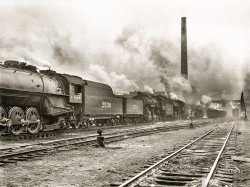
- Esplanade Ave.: 1910
- ... Detroit Publishing Company. View full size.
Louisiana's bi-centennial 1984 Louisiana World Exposition, in New Orleans , 100 years after the 1884 World ... Posted by Dave - 12/10/2017 - 4:19pm -
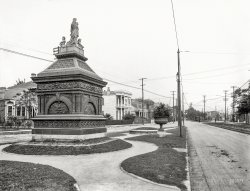
- Louisiana Noir: 1932
- September 1932. "Louisiana State Capitol at Baton Rouge. Tower lights at night. Gov. O.K. Allen. ... Posted by Dave - 02/10/2014 - 4:05pm -
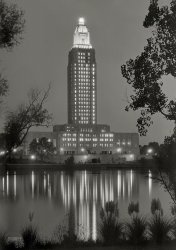
- Picnic Munch: 1942
- ... Cola I didn't come along until 1957 and we lived in Louisiana, but one of the constants of my childhood (and there were not all ... Posted by Dave - 08/21/2023 - 2:08pm -
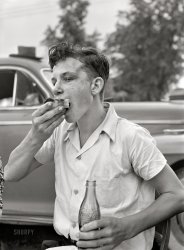
- Louisiana: c. 1880s
- This has to be either Covington, Louisiana or New Orleans. My mother told me these are probably my great-great ... Posted by catsoldpics73 - 07/12/2011 - 4:08pm -
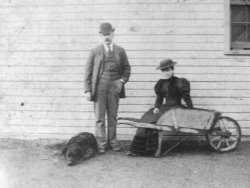
- Woodlawn: 1938
- Assumption Parish, Louisiana, 1938. "Woodlawn Plantation, Napoleonville vicinity. Built 1835 by Col. W.W. Pugh, first superintendent of schools in Louisiana." 8x10 inch negative by Frances Benjamin Johnston. View full size. ... one farmer unafraid of ghosts.
I like these shots of Louisiana you post. What a grand old home this was. Thanks Dave!
... Posted by Dave - 07/22/2012 - 4:44pm -
![Woodlawn: 1938 Assumption Parish, Louisiana, 1938. "Woodlawn Plantation, Napoleonville vicinity. Built 1835 by Col. W.W. Pugh, first superintendent of schools in Louisiana." 8x10 inch negative by Frances Benjamin Johnston. View full size.
Laundry dayA couple of shirts between the two left columns.
Inside viewWouldn't you love to look inside of this to see what remained after all those years?
Do not strikeThat actually looks like a lightening rod, missing its fragile glass ball. Its two other friends on the roof ridge are a bit worse for wear.
[Lightening: what happens when you diet or bleach your hair. Lightning: electricity from sky. - Dave]
TotteringI once remarked to an elderly lady that the shed in her back yard looked like it was about to fall over. She said that it had been that way for years but it was still standing because the "termites were holding hands."
Probably not a radio antennaMore likely, being 1938, a lightening rod.
[Or a darkening rod. Radio had been around a long time in 1938. - Dave]
Hey Good Buddy?It looks like a Star Duster™ CB antenna on the ridge of the weathered centermost building. Obviously it's not, but I wonder what it really is?
[A radio antenna. - Dave]
I dare youThis place looks so haunted you wouldn't want to go near it in broad daylight.
It looks like loose hay spilling out of the windows of the smaller bookend buildings, so there must be at least one farmer unafraid of ghosts.
I like these shots of Louisiana you post.What a grand old home this was. Thanks Dave!
Porch-fallIf a porch falls and nobody hears it, does it make a sound?
From stately to firewoodMy desktop copy of The History of Louisiana's Plantations tells me that much of Woodlawn's wood (probably a pun in there somewhere) as the structure moldered into the ground was used for firewood by cane field laborers. The property had 2,300 acres, 800 of them planted with sugar cane, so there were lots of folks looking for something to burn.
But in its day, the place was something:
According to Dr. Thomas Boyant Pugh of Napoleonville, Woodlawn was built by his father, William Whitmell Pugh, in 1840 and the wings were added after a second marriage to Josephine Nicholls in 1850. Woodlawn was not only modern in its planning, but we are told that the first installation of gas in Louisiana was in this house, as also a speaking tube from the dining room to the upstairs bedroom, and a bathroom, which was still a rarity at the time. More here.
Hay thereLooks like the place was turned into a stable.
A pretty faceInteresting how some of these old plantations are like Hollywood sets, all facade.
Mon dieuC'est magnifique!
Burned in 1962The word "rickety" must have been coined with this place in mind.
Interior Photos!A few cool interior shots like this one can be found here.
Magnificent yet heartbreakingly eerieMy great-grandfather was born into U.S. slavery on Woodlawn Plantation.
(The Gallery, F.B. Johnston)](https://www.shorpy.com/files/images/01619a1.thumbnail.jpg)
- Louisiana (Colorized): 1937
- Colorized from this Shorpy original. My second attempt at colorizing. I think I'll try to do one every month. View full size.
Keep Going joleine, please keep going. You are one of the Shorpy Colorists now.
Excellent job on the u ... Posted by joleine - 06/05/2015 - 7:38pm -
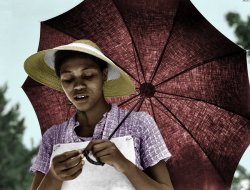
- Louisiana (Colorized): 1937
- From this Shorpy original. The color gets a little compressed. I just thought she was beautiful and wanted to try colorizing. View full size.
(Colorized Photos) ... Posted by Deborah - 02/15/2013 - 8:58pm -
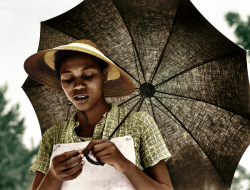
- Legal Briefs: 1925
- ... circa 1925. "Tepper Building, Standard Engraving Co., 470 Louisiana Avenue N.W." The Tepper family business is what you might call ... outside. One is wearing pumps. - Dave]
Long gone Louisiana Avenue in the northwest quadrant of DC is just a short 3-block ... Posted by Dave - 07/12/2011 - 9:19pm -
![Legal Briefs: 1925 Washington circa 1925. "Tepper Building, Standard Engraving Co., 470 Louisiana Avenue N.W." The Tepper family business is what you might call vertically integrated: Joe's law practice upstairs, above Saul's "Notions, Hosiery, Underwear." National Photo Company Collection glass negative. View full size.
Two for OneGet defended and hosed at the same time!
(Does George Washington live next door?)
HeadsThose two heads peering out of the Estes Building entrance give this photo a certain creepy effect.
[Plus the three ghosts outside. One is wearing pumps. - Dave]
Long goneLouisiana Avenue in the northwest quadrant of DC is just a short 3-block segment running from Constitution Avenue to Union Station, a stone's throw from the Capitol.
"Legal Briefs"may be the very best of Dave's pun-ishments of Shorpy viewers!
Keep 'em up!!
[So to speak. - Dave]
Tax BrassSign over the entrance to the building on the left: "Bureau of Internal Revenue," now known as the IRS.
1925 EssexThe car parked at the curb is a Second Series 1925 Essex 6 Coach, built after March of that year. Essex pioneered the first low priced closed car with the introduction of its five-passenger Coach in 1922, which was an immediate success. The 1925 Essex was the first closed car that sold for the same price as an open touring car. By October of '25 you could buy one of these cars for $765, which was only $105 more than the price of the Ford Fordor Sedan. Essex sold 159,634 cars in 1925.
The old Louisiana AvenueBefore 1933, this block of Louisiana Avenue was adjacent to Judiciary Square - here it is on a 1911 map:
The section of Louisiana south of Pennsylvania Avenue was built over during the construction of the Federal Triangle, prompting Louisiana senators to argue that the remaining, smaller road was an affront to their state's dignity (see "Fight Over Name of Thoroughfare Will Be Vigorous", 11/28/30 Washington Post).
The name was being applied in its current location by 1933. The remaining stub of Louisiana became part of Indiana Avenue NW.
The city bought the Tepper Building in December 1932 and condemned it to make way for the never-completed Municipal Center complex. I'm not sure when it was finally razed, but it's definitely gone now.
Death and taxesThe building at left--462-464 Louisiana Ave., occupied here by the Bureau of Internal Revenue--housed the Army Medical School until its relocation to Walter Reed in 1922.
(The Gallery, D.C., Natl Photo)](https://www.shorpy.com/files/images/33027u.thumbnail.jpg)
- Nawlins: 1903
- ... a few court proceedings and in "History of the Jews of Louisiana."
By the breadth of the street, I would guess it's Canal. I ...
Enjoyable challenge Although I've never been to Louisiana, some brief research indicates that this photo is of St. Charles ... Posted by Dave - 07/19/2012 - 4:32pm -
![Nawlins: 1903 Circa 1903. The caption for this glass negative has been misplaced -- who will be the first person to identify this city and its famous thoroughfare? UPDATE: And the answer is, as most guessers correctly guessed, Canal Street in New Orleans! 8x10 inch dry plate glass negative, Detroit Publishing Company. View full size.
Who Dat!Very apt posting a pic of old New Orleans here. If my Steelers can't win the Super Bowl this year, then Go Saints!
Would it beNew Orleans? I think it is!
Anytown, USAis New Orleans.
Krower ClueLeonard Krower had a shop at 536-538 Canal Street in New Orleans.
NewOrleans.
Might it beCanal Street in New Orleans? Found this through google: http://www.neworleanspast.com/ads/id49.html
Canal StreetCanal Street, in New Orleans. Personally, I've never been there, but searching for "Leonard Krower" shows he was a prominent jeweler in the city.
New Orleans?http://files.usgwarchives.org/la/orleans/bios/p-000002.txt
Never been there, don't know if it looks like it or not.
Semi-wild guessMain Street in Charlottesville, Virginia.
New OrleansS.E. Worms was a retailer and appears in a few court proceedings and in "History of the Jews of Louisiana."
By the breadth of the street, I would guess it's Canal. I haven't found an address of Mr Worms' establishment.
I do hope he renamed it at some point. "Hey, you like my Worm suit?" doesn't sound all that great.
My GuessCanal Street, New Orleans.
http://www.neworleanspast.com/ads/id49.html
Yes, Canal St in N.O.http://www.hnoc.org/collections/gerpath/gersect5.html
"Dalsheimer & Worms Notions & Gents. Furnishing Goods New York/New Orleans (Canal St.). Business form with elaborate letterhead. Acc. No. 1983.3.1."
Looks Like...Canal Street, New Orleans
Canal Street, New OrleansIt looks like thats Leonard Krower @ 536 Canal Street in New Orleans, LA (ad for them here: http://www.neworleanspast.com/ads/id49.html)
Is this New Orleans?Canal Street.
New Orleans?Leonard Krower Jewelers building was my clue.
Anytown, USA, foundThis looks like New Orleans, LA., at least according to Google. S. E. Worms and Leonard Krower companies were both there in this time frame.
New Orleans, LaWhat did I win?
New OrleansCanal Street, New Orleans
New Orleans!Looks like New Orleans, here's a pic
http://content.cdlib.org/ark:/13030/kt4b69p81d/?order=2&brand=calisphere
Where is This?Canal Street, New Orleans
Canal St. NOLALooks like Canal Street. A load of cotton seems to be in the middle of the pic.
It could be ...Canal Street in New Orleans
New OrleansNotions on 76 & 78 Canal Street.
19 streetcars!On Canal Street, New Orleans.
Future Saints fansIt looked like a Southern city even before I saw the cotton bales. Most likely Canal Street in New Orleans.
NOLA, maybe Krower Wholesale Jewelers (@ left) and the Bucklin Advertising Concern (obscured sign @ right) both appear to have been New Orleans firms.
A few - not 100% convincing - Web sources put Krower at 111 Exchange Place (at Canal).
My guess?Canal Street, New Orleans. Found this stereo photo from long ago ...
http://content.cdlib.org/ark:/13030/kt4b69p81d/?order=2&brand=calisphere
Canal Street, New OrleansA Google search on '"S. E. Worms" notions' turned up this entry from Google Books on the undated (apparently late 1800s) book "New Orleans and the New South": http://books.google.com/books?id=xrY-AAAAYAAJ&pg=PA107&lpg=PA107&dq=%22S...
The building's 76-78 Canal Street address is helpfully noted right under a charming blue-ink drawing on page 107 of the same building seen here in the photo.
And for extra credit, here is a Google Street View of roughly the same address today: http://maps.google.com/maps?f=q&hl=en&q=78+Canal+Street,+New+orleans,+la...
Worming That's Canal Street in New Orleans. In the foreground we have 76-78 Canal, the former home of S. Dalsheimer & Co., which was illustrated in "New Orleans and the New South," by Andrew Morrison. Mr. S.E. Worms was the resident partner, and it looks like he took over the business eventually.
"The engraving which illustrates this matter hardly does justice to the premises they occupy - premises themselves indicating a house which is conspicuous by reason of the business done by it throughout the trade territory of New Orleans."
Some Google-triangulating suggests..Canal Street, Mew Orleans.
It could be ...Canal street New Orleans La Identified by the streetcars, cotton bales and Searcy & Pfaff printer business. Future home of the Saints! Who Dat?
Saints Alive!We're apparently seeing a scene from Leonard Street in bustling New Orleans.
http://books.google.com/books?id=4yrZAAAAMAAJ&pg=PA117&lpg=PA117&dq=%22l...
Anyone from Nawlins able to tell us if that street's been renamed?
Enjoyable challengeAlthough I've never been to Louisiana, some brief research indicates that this photo is of St. Charles Street in New Orleans.
A Google search of Searcy and Pfaff printers (displayed here across a 3rd-story window) led to an incredibly-informative biography of William Pfaff.
http://files.usgwarchives.org/la/orleans/bios/p-000002.txt
"On November 1, 1889, Mr. Pfaff, then only eighteen years of age, became associated with his brother-in-law, David J. Searcy, in the operation of a little job printing establishment occupying one room on the third floor of a building on St. Charles Street, near Gravier."
Could it be? Will some true New Orleans people confirm?
I think I knowBy looking at that white building with the rounded corner, about a block from the Orpheus Theater, I would say this was Canal Street in New Orleans. If that building is on Carondelet Street, that's got to be it!
H.B Stevens et alA short session of Google-business-name-triangulating suggests it's Canal Street, Mew Orleans.
[Funny, you're the second cat to guess Mew Orleans. - Dave]
Lovely Canal StreetI believe we are looking at Canal and Camp streets.
View Larger Map
ShreveportHow about Shreveport, La.? According to Shelden's Jobbing Trade & City Offices (published in 1901), the firm operated at 43 Leonard St.
http://books.google.com/books?id=4yrZAAAAMAAJ&pg=PA117&lpg=PA117&dq=%22S...
Holy Toledo, I count 19 cable carson Canal Street. Business is good!
[The number of cable cars in this photo is zero. These are electric streetcars. - Dave]
Sharp ShorpiansShorpsters were once described by our host as "a school of fact-checking piranhas." I saw this pic about an hour after it was posted and there were already 37 guesses and most were correct. Way to go Shorpsters!
I'm in awe!All you knowledgeable people impress me! Is that the spire from Saint Louis Cathedral visible behind the building that says H.B. Stevens?
Is that fellow posing?Or is the fellow in shirtsleeves and a bowler, standing on the roof of the building behind Dalsheimer's, just getting a breath of air while enjoying the view?
I never fail to marvel at the lack of vertigo apparent among some of the folks caught in these frozen moments. The window washers and roof-ridge-walkers couldn't possibly have realized that they were being included in a camera shot at the time the photograph was taken. Were people that much less fearless then?
The spireBased on the time (just after 9 a.m.) and the shadow, the camera is pointing almost due west.
So that cannot be St. Louis, which is east of this vantage point.
Streetcars and SaintsI spent Christmas in New Orleans with the girlfriend, and was surprised to find out that the city has the oldest functioning streetcar system in the country -- when other cities began giving them up in the 1930s, N.O. hung onto its.
And ... GEAUX SAINTS! A lifelong dream has been realized.
VantageI think this photo was shot from atop the Custom House. It is looking towards the lake. The big building in the middle still stands at Carondelet and Canal. Find the building with the storm shutters, directly to the right of the picture, towards the bottom. It is the oldest building still standing on Canal Street. It is at the downriver, lakebound corner of Canal Street and Decatur Street. It is now a Wendy's or an Arby's.
Great Birthday CityThis is one of the world's great party cities. In fact, next Tuesday Kairha and I embark on a 10 day road adventure, ending up in N.O. And I recently found out that on my birthday (Tuesday, week) the entire city has gotten together to organize a huge celebration for me!
With parades and everything! What a city!
CaryatidsLeonard Krower has a fine set of them holding up the roof.
H.B. StevensH.B. Stevens (Est. 1860) merged with Porter's on Baronne Street to become Porter Stevens in the 1970s. It is the oldest men's clothing store in New Orleans. The building in the picture was built in the early 1880s.
Here's another view of the same building.
http://www.porterstevens.com/
Photo Taken from Stauffer, Eshleman & Co. Wholesale HardwareWe featured this picture as our weekly photo quiz on www.forensicgenealogy.info. Diane Burkett and Arthur Hartwell, a couple of our top Quizmasters, pointed out that the Godchaux tower was close to the photographer, and that there is no break in the awnings to indicate the picture was taken on the river side of the corner of Canal and Dorsiere Sts.
Diane found that Godchaux's was then located at 527 Canal (the street has since been renumbered), and that the most likely location for the photographer was from the upper stories or roof of Stauffer, Eshleman & Co., 519 Canal St. This is now the location of the Marriott. Diane consulted the Sanborn Fire Insurance Maps to come up with this conclusion.
www.forensicgenealogy.info/contest_294_results.html
I am from New Orleans, and have featured several NO pictures in my weekly quizzes. A couple have come from Shorpy. To see them, scroll down the answer page (linked above), and look for the box in the right margin near the bottom.
Colleen Fitzpatrick
Quizmaster General
Forensic Genealogy
www.forensicgenealogy.info
Yes, Canal St New Orleans towards the RiverAs most figured, this is definitely view down Canal Street in New Orleans towards the lake. Several of these buildings still exist. At least one business also still exists: Werlein's Music (they moved to the other side of Canal after this photo was taken (that building now houses the Palace Cafe restaurant), and in the 1980's moved the suburbs.
Note that drays are traveling in both directions on the downtown side of the neutral ground, a situation that lasted into the early automobile days.
(The Gallery, DPC, Horses, New Orleans, Streetcars)](https://www.shorpy.com/files/images/a39701a4_9.thumbnail.jpg)
- Grocery Run: 1940
- July 1940. Natchitoches Parish, Louisiana. "Mulattoes returning from town with groceries and supplies near ... have no rubber rims, there are no springs, either!
Louisiana Creole Creoles in Louisiana are very proud of their heritage. There is a rather large community ... Posted by Dave - 10/05/2011 - 7:51pm -
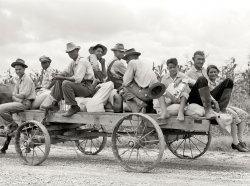
- Cane Train: 1897
- Circa 1897. "Cane fields in Louisiana." Glass negative by William Henry Jackson. View full size.
... my nose). Tastes like sugar.
Beware the cane fields of Louisiana When our family lived in southern Louisiana for a while, we kids would play in the cane fields. I'd use my trusty ... Posted by Dave - 12/13/2020 - 2:21pm -
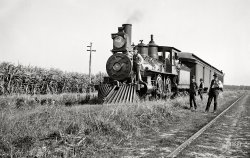
- New Denechaud: 1908
- ...
[Horticulture a la Morticia Addams. - Dave]
Louisiana We dont speak French here. We speak Cajun, a 200 year old ...
Yes, shells on roof There are no stones in south Louisiana. Mollusk shells dredged from brackish Lake Pontchartrain were used as ... Posted by Dave - 08/05/2012 - 4:24pm -
![New Denechaud: 1908 New Orleans circa 1908. "New Hotel Denechaud, Poydras Street." A century later, it's the hotel Le Pavillon. Detroit Publishing glass negative. View full size.
Le PavillonMy wife and I stayed there several years ago, and we had dinner there just a few weeks ago. The dining room is on the ground floor in the corner nearest the camera.
It's a very nice hotel with a unique touch. Every night at 11, they serve to the guests peanut butter sandwiches on silver trays, and hot chocolate from silver urns.
But the people who work there apparently can't pronounce the name of the hotel with proper French diction.
Creole, not CajunNew Orleans is not a "cajun" city. It is creole at best, and if anything most street names aren't pronounced correctly either.
French diction?This isn't Paris -- it's Nawlins!
CoverageAre those sea shells on the roof in the foreground? I believe most modern roofs use stones. Interesting.
Very beautiful building! I can imagine how impressive it was at the time!
Roof GardenIs that a little ivy garden boxes on the roof of the building in the corner? Sure looks it!
[Horticulture a la Morticia Addams. - Dave]
LouisianaWe dont speak French here. We speak Cajun, a 200 year old corruption of French, so don't expect proper French pronunciation.
Early Sunday morningGiven the long shadows for the low sun and the orientation of Carroll Street, and the absence of anyone except the lone blurred horse and cart (deliveries), sure looks like an early Sunday shot to me. Real nice photo too!
[Also note the shadowy figure in the alleyway. - Dave]
Denechaud / DeSoto / Le PavillonIn between its opening as the Denechaud and the current name of Le Pavillon, for generations the hotel was known as the DeSoto. I recall when the question of correct pronunciation of "Le Pavillon" came up, a local old timer piped in "De Soda."
The text on the back of the attached early 20th century postcard view of the lobby reads "$1,000,000.00 Hotel DE SOTO New Orleans. The ONLY ABSOLUTELY FIREPROOF HOTEL IN NEW ORLEANS. ALL OUTSIDE ROOMS. Famous for its Creole Cuisine. Rates $1.00 and Upwards."
The lobby is still one of the most beautiful in the city. I believe the rates have gone up.
Lots of charmLovely building! The chimney is blowing off quite some smoke - must have been a windy day!? Le Pavillon still looks charming today and, I just found out, seems to be famous for the occasional ghost apparition.
Max Barnett Furniture Co.Max Barnett Furniture Co. can be seen in the background. It was established there on Poydras St. in 1899, and was located there until they moved in 1928.
Smokestacks still thereThe two smokestacks are coal burning stacks, which were used for producing electricity until 1973. They are located in the 1200 block of South Peters Street. Maybe someone else can help identify the other tower, as it was prominent in the New Orleans skyline until a few years ago.
Yes, shells on roofThere are no stones in south Louisiana. Mollusk shells dredged from brackish Lake Pontchartrain were used as gravel throughout the area until quite recently. Dredging in the Lake was banned in 1990 to reduce the turbidity and stirred-up pollution. The lake is now clean enough for swimming much of the time. I've also seen oyster shells used for gravel in NOLA.
(The Gallery, DPC, New Orleans)](https://www.shorpy.com/files/images/4a23119a.thumbnail.jpg)
- Uneeda Banana: 1921
- ... Fruit Co." Salvatore Scalco's produce business on Louisiana Avenue. National Photo glass negative. View full size.
Banana ...
Sure it's Washington? It is Lawrence Ave, not Louisiana - check out the canvas sign - and I can't locate a Lawrence Ave NW. ... Posted by Dave - 09/13/2011 - 11:31am -
![Uneeda Banana: 1921 Washington, D.C., circa 1921. "National Fruit Co." Salvatore Scalco's produce business on Louisiana Avenue. National Photo glass negative. View full size.
Banana Benefit
Washington Post, Nov 15, 1925
Sales of Bananas Net $100 For Red Cross
About $100 was collected for the Red Cross yesterday by Salvadore Scalco, local fruit merchant, who auctioned a wagon load of bananas to government workers at the Munitions and Navy buildings. A crowd quickly gathered and purchased the fruit as Scalco, with true Italian fervor, delivered an impassioned plea in favor of the District roll call fund of the Red Cross.
The groups of government employees appeared particularly impressed with the orator's eloquence after Gen. John A Johnston, chairman of the roll call for the District chapter of the Red Cross, explained that "this native Italian is doing this to show his gratitude toward the great country which gave him is opportunity." Scalco himself referred several times to his appreciation of the advantages accorded him by the United States. He said he had "not forgotten, either, the help the American Red Cross gave Italy."
So enthusiastic was the auctioneer that many who came to stare remained to buy. Once a policeman, on duty in the vicinity of the Navy building, interrupted the speaker, but Scalco presented credentials from Maj. Hesse, superintendent of police, authorizing him to hold the banana sale. His cry of "Bananas! Buy a nice bunch for the benefit of the Red Cross!" sometimes brought more that a dollar for a single bunch of fruit.
Last year Scalco held a similar sale for the Red Cross, netting about $200 to the organization fund. He did not appear entirely satisfied with the proceeds of yesterday's work, and promised the chairman of the roll call to arrange for another sale for the benefit of the organization.
Years ago Scalco came to the United States as a poor immigrant. Today, he has established himself in a profitable fruit business, officials of the Red Cross stated. Annually, he holds a sale of bananas to evidence his appreciation of the opportunities afforded him here.
Washington Post, Jan 31, 1926
Banana Ban Stirs City Fruit Dealer
Salvatore Scalco, Head of the Largest
Company here, Protests Ruling at Jail.
Maj. W.L. Peak's reported ban against receipt of bananas by prisoners in the District jail has roused the ire of Salvatore Scalco, president of the National Fruit Co., Inc., one of the largest dealers in bananas in Washington.
"Bananas," said Mr. Scalco, "are very nutritive, enjoyable fruit and are not more susceptible to being made carriers for hidden saws than apples and oranges may be made vehicles for poisons or what you will."
Not content with his own efforts to have the ban raised, Mr. Scalco has forwarded to national fruit companies copies of the story printed in the Post and insists they get busy against the ban. "If bananas are left on the stalk nothing can be inserted in them without breaking the skin and this can be detected easily," he declared.
Sure it's Washington?It is Lawrence Ave, not Louisiana - check out the canvas sign - and I can't locate a Lawrence Ave NW.
Unless DC has changed street names.....
The tag on the building sign says "OJ Guide CO. N.Y.". Now would they be painting walls in Washington?
[You're confusing the name of a business with the name of the street. Lawrence, Abell & Co. was the wholesale grocer at 723 Louisiana Avenue. O.J. Gude (later General Outdoor) is the New York-based ad agency that sold space for the sign. - Dave]
Gone BananasI believe those bananas on the cart are of the Gros Michel variety. Bigger and better tasting than the ones we find in the supermarket today. Apparently they are nearly extinct, victims of a banana disease.
http://www.popsci.com/scitech/article/2008-06/can-fruit-be-saved
I wish I could go back in time for a taste test.
Back to old LouisianaAnother view of the "old" Louisiana Avenue, a section of which survives as Indiana Avenue NW:
http://www.flickr.com/photos/57668330@N00/1638282582
It apparently had a long run as a hub for produce, dairy, and meat wholesalers - here's a view from 1906:
http://www.flickr.com/photos/rock_creek/1637147041/
Salvatore ScalcoSalvatore Scalco was my Grandfather. Thank you for posting the articles about him.
Joe TortoriceThis is amazing. My great grand uncle Joseph Tortorice was a banana deliveryman for National Fruit from the 1920s until sometime in the '30s. I wonder if that's him in the photo?
(The Gallery, D.C., Horses, Natl Photo, Stores & Markets)](https://www.shorpy.com/files/images/22374u.thumbnail.jpg)
- Normal: 1940
- ... to 'thumb' a ride home over the weekend near Natchitoches, Louisiana." Photo by Marion Post Wolcott for the Farm Security Administration. View full size.
Louisiana State Normal School Northwestern State University in Natchitoches ... Posted by Dave - 06/27/2019 - 12:13pm -
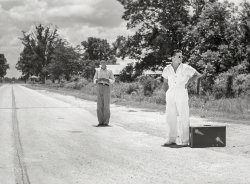
- A Friendly Game: 1938
- ... 1938. "Game of coon-can in store near Reserve, Louisiana." 35mm negative by Russell Lee for the Farm Security Administration. ... of a Smile That guy fancies his chances.
Reserve, Louisiana I grew up in Reserve in the 1950's and '60's. I'd love to get some ... Posted by Dave - 09/09/2011 - 6:36pm -
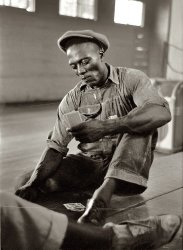
- The Rookery: 1938
- 1938. St. Charles Parish, Louisiana. "The Rookery, Trepagnier House. Norco vicinity. Abandoned plantation ... that evolved in the extremely wet climate here in Louisiana.
That's pure Louisiana Nothing to do with Palladianism.
Sleep under the stars Do ... Posted by Dave - 08/30/2012 - 11:03am -
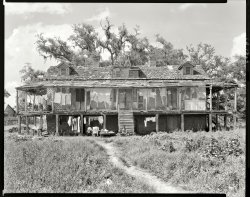
- Fais Do-Do: 1938
- ... fais-do-do at National Rice Festival ( video ). Crowley, Louisiana." View full size. Medium format negative by Russell Lee.
Rice ... remind me of a flamenco dancer's costume.
Crowley, Louisiana My wife's family is from Crowley, and not much has changed since ... Posted by Dave - 04/15/2008 - 1:00pm -
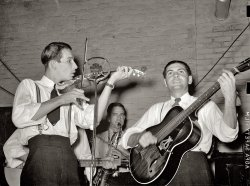
- Vicksburg: 1910
- ...
♪♫ Way down around Vicksburg, around Louisiana Way...♪♫ ♪♫...lived a Cajun lady, we called her ... Posted by Dave - 11/15/2011 - 6:06pm -
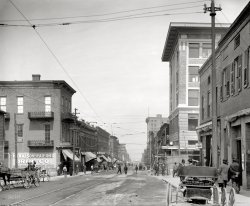
- Birdman of Washington: 1915
- ... whose grocery ("fancy fruits and vegetables") was at 924 Louisiana Avenue N.W. Harris & Ewing glass negative. View full size.
... is the P.K. Chaconas & Company (Inc.), at Ninth and Louisiana avenue northwest.
Its officers, P.K. Chaconas, president; P.C. ... Posted by Dave - 08/27/2012 - 11:52am -
![Birdman of Washington: 1915 Washington, D.C., circa 1915. "P.K. Chaconas Co. Market." Pictured: Proprietor George Chaconas, whose grocery ("fancy fruits and vegetables") was at 924 Louisiana Avenue N.W. Harris & Ewing glass negative. View full size.
Genuinely PleasantHow rare it is to see a sincere and guileless smile on a person's face. Such direct and genuous happiness is impossible to fake. This is a kind and happy man.
Oldest Greek MarketWashington Post Jul 2, 1922
P.K. Chaconas & Co., Inc.
The oldest established Greek-American firm in the Capital and probably the most prominent and successful one is the P.K. Chaconas & Company (Inc.), at Ninth and Louisiana avenue northwest.
Its officers, P.K. Chaconas, president; P.C. Nicolopoulos, vice president; Chas. Chaconas, secretary and treasurer. E.G. Nicolopoulos and P.G. Xedes, founded the business seventeen years ago, dealing in fruits, vegetables and groceries. As the commission district grew, so did the company. Their slogan reads: "Honesty in all business dealings," and it is safe to say that is quite correct.
The charter member of the firm, P.K. Chaconas, first started the business at 1440 P street northwest, near Riggs market, more than a quarter of a century back. The latter is accredited for having originated in Washington the store on wheels, more familiarly known as the huckster wagon.
The aforementioned members of Chaconas & Company are active in all Greek-American affairs in business and society.
Additional Notes:
Moved to pictured location ("Pickford's Old Stand") circa November 1906.
The location of Louisiana Ave has changed over time such that Ninth and Louisiana do not intersect on the contemporary map of Washington D.C. The location of this photo would be in what is now eastern edge of Federal Triangle - just west of the current National Archives building.
Top portion of Washington Monument visible in backgroud.
The Washington Post refers to "huckster wagons" as early as 1878
Earliest mention of 'Chaconas' in Washington Post archives is Aug 14, 1894: George Chaconas was fined (along with a dozen other Greeks and Italians) for lingering too long and obstructing the street with a vending push cart.
This block of Louisiana Avenue is just west of Center Market and seems to have accommodated an overflow of merchants and wholesalers.
1909 map from Baist's Estate Atlas
His wife, and fluffy bunnies, tooIs that his wife we see in the left-hand side of the frame? Also note the fresh rabbits, atop the open crates.
PrideI see a man who is so very proud of what he has built up (I would bet from nothing) since he, or maybe his parents came to the United States. The Land of Opportunity.
Yech.One would think he would stop smiling long enough to sweep that filthy sidewalk he is selling food on !!
The Source of GreatnessI fully concur with Lincoln's remarks and would like to take it a step further. Small businesses (like this one) were/are the foundation for a community's and a country's greatness. His genuine happiness was surely the result of more than commercial success. We can learn a great deal by understanding the personal stories of such gentlemen and ladies.
Local LandmarksNote the Washington Monument sticking up behind the roof.
Xmas 1915I love the Christmas greenery. (The notice by the window is promoting a Charity Ball for Monday, January 3, 1916.) When I was a small child in the mid-1950's, my grandma used to go to a butcher where you could pick out your live chicken and they would kill, clean and dress it for you. This brings back memories. He does look like a happy man, as does she.
What made America great!This is a beautiful picture of a man truly proud of what he does and where he does it.
Trusting soulTwo cash registers, no waiting! I bet they wouldn't last two minutes out in the open street today.
Haconas?The banner at the top center, under the overhang: we can see a partial K and a period, followed by HACONAS & CO. Where's the C?
[The left section overlaps the right. - Dave]
Central MarketIs this essentially part of the old Central Market?
Deja viewIsn't this the same butcher shop that was proudly displaying a row of greasy old possums a couple of weeks ago?
[That was in New York. This is Washington. - Dave]
My great grandfatherThis is a photo of my great grandfather in front of the business that he built up from nothing. Although our times did not cross, I grew up with the family stories, seeing this picture is like getting a piece of my history. Where did you find this and do you have any others?
[This photo is part of the Harris & Ewing collection of glass negatives at the Library of Congress. There's a photo of a Chaconas delivery truck here. - Dave]
(The Gallery, D.C., Harris + Ewing, Stores & Markets)](https://www.shorpy.com/files/images/00048a.thumbnail.jpg)
- Rice Creek: 1890s
- ... it Once Was Oh, for a time machine.
"Down in Louisiana" Yes, I know this is Florida, but as soon as I clicked on ... Posted by Dave - 05/18/2014 - 12:31am -
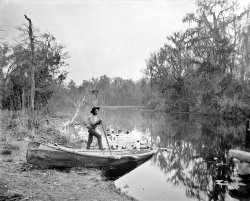
- Ask About Our Brains: 1920
- ... of like Lite Butter or Shedd's Spread.
Hanging on Old Louisiana Hoover & Denham was a meat distribution firm operating in the 900 block of Louisiana (now Indiana) Avenue NW.
We've seen this neighborhood - a hub ... Posted by Dave - 09/13/2011 - 8:12pm -
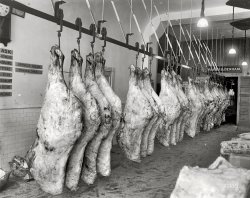
- School's Out: 1942
- ... remember anyone without shoes in school, and I lived in Louisiana! The barefoot kids aren't carrying any shoes so I assume they came ... Posted by Dave - 08/11/2023 - 6:25pm -
![School's Out: 1942 July 1942. "Dunklin County, Missouri. Children leaving school." Acetate negative by Arthur Rothstein for the Office of War Information. View full size.
What a Great Photograph!Not much more to say than what a fabulous shot this is! A truly timeless photo especially when you consider it is over 80 years ago!
That's a lot of kidsfor a rural area. From what I could find, the school building, and the school district is gone. But its memory lives on in its own Facebook page, Bucoda Public School District No. 57. Interesting reading.
Shoes?I certainly went barefoot in the summer on occasion as a kid but I don't remember anyone without shoes in school, and I lived in Louisiana! The barefoot kids aren't carrying any shoes so I assume they came to school unshod?
Happy DaysA smile on every face! As old as I am, I can still remember the feeling of bursting out of the schoolhouse for summer vacation. Wonderful feeling. What a variety of kids here. Some barefoot, some in bib overalls and all of them trim and slim.
TV, phones and computers will change that.
Enjoy the summer kids.
[Actually these kids are just starting school. - Dave]
Explosive joyWow, those kids are exploding out of that school! Such a high degree of happiness in every single face. What a crazy amount of energy. And I love the bare feet, too.
Barefoot studentsI notice that several kids are running toward the camera barefooted. Would this be something common in the 1940's in Missouri. Might be fun, but in a crowd of running kids with mostly shoes on, I would have been worrying about my feet!
Reminiscent of a Paul Detlefsen Painting
Third ClassThe 102 by 80 foot building was still quite new in this picture, having opened in 1940. No mention if any of those feet were unshod.
Many have commented on the youthful enthusiasm, but a 1929 article on attendance hints at the challenges in a poor, rural school of the period; the class sizes - first 51, second/third 32, fourth/fifth 30, sixth/seventh/eighth 47, HS 7 - might seem bizarre until one realizes why: people dropped out (the huge dip after first shows how many and how early.) Unlike today, where school is seen as a place to escape from, it must have been a place to escape to...albeit briefly.
Bucoda AlumsI gather the school itself is gone, but there is an active Facebook group for alums: https://www.facebook.com/groups/1219721161462592
(The Gallery, Arthur Rothstein, Education, Schools, Kids)](https://www.shorpy.com/files/images/SHORPY-8d07576u1.thumbnail.jpg)
- Shorpy Higginbotham: 1910
- ... were in old age they moved with with their sons to the new Louisiana Territory, E. Feliciana Parish. My gggfather was Caleb Higginbotham ... Posted by Dave - 02/14/2022 - 3:03pm -
![Shorpy Higginbotham: 1910 December 1910. "Shorpy Higginbotham, a 'greaser' on the tipple at Bessie Mine, of the Sloss-Sheffield Steel and Iron Co. in Alabama. Said he was 14 years old, but it is doubtful. Carries two heavy pails of grease, and is often in danger of being run over by the coal cars." Photograph and caption by Lewis Wickes Hine. View full size.
Shorpy storyThe story about this boy makes me so sad. The photo is so strong. Esthetically - wonderful - artistic movie like.
Thanks for sharing it with all of us. Tamara Razov.
His armsThose are the roughest part--it appears that they're rather permanently in that position.
Notice His Hands...You can tell Shorpy worked very hard. His hands look like the hands of a 40 year old man, not a 14 year old boy. His arms do appear to be permanently bowed out and his shoulders are sloped from carrying the heavy buckets.
How we could ever have gotten to this point in our society is beyond me. Thank goodness for the progressive people back then who put a stop to such practices and gave kids like Shorpy their childhoods.
omg. after seeing theseomg. after seeing these pictures, its so hard to believe how far we have gone and what todays world is like compared to back then. The question is, what would they think if they saw what the world was like today and how people are living?!
(perfect example, we now have cars that drive for us!!!)
Shorpy and child laborThe pictures were taken only 30 years before I was born.
When I was 14 I needed a State of California Work Permit in order to get a summer job (picking cotton).
We could quit school at 16. I didn't do that but many did.
Thank God for the reformers in the early 20th century!
"The golf links lie so near the mill that almost every day, the working children can look out and watch the men at play."
Don
Lest we forgetIt is easy to forget from the perspective of our comfortable North American lifestyles that in many places in the world, child labor still runs rampant, not because families want their children to work endless hours in deplorable conditions, but because their very existence depends on the meager income the children earn. Let's not become too complacent and self-satisfied that we've "progressed" beyond the conditions of the early 20th century until we've globally eradicated those same conditions that continue to exist today.
picture from a greaser kid... ... cause of his size he was able to easily go inside all the mechanics stuff.. they see it as a game... some great technologics developments were the outcome of that work-players boys... thats the good one... the bad one is that some of them never play again...
So great wonder!Really I'm so scare about you beautiful eye-moment, serious, I think in a lot of stuff's, that amazing like a time capsule... Don't have the exactly words for tell you my reasons... make my day theses snaps.
I hope back soon.
Carlos "Cx"
Shorpy's contemporariesA ten-year-old working in the mines was not unusual. My grandfather was born in 1896 and started in the mines at age ten. He worked for Tennessee Coal and Iron in Jefferson County, Alabama. After his back was broke in a mine accident and suffering from years of black-lung he lived to 84.
This was before welfareAmerica is still the greatest place in the world to give. I have traveled to a lot of countries. Yes, they have their pluses, but even the poorest americans live better than 99% of the worlds population.
Shorpy HigginbothamI wonder if anyone knows where Shorpy Higginbotham's grandfather, Robert Higginbotham, is buried.
Robert Higginbotham is my Great Great Grandfather.
Kenny Brown
twotreesklb@aol.com
Shorpy, descendant of Revolutionary War SoldierShorpy was my father's (Roy Higginbotham's) uncle, a younger brother of my grandfather, John W. Dolphus Higginbotham. Their ancestor Robert Higginbotham was a Revolutionary War soldier who fought in the Battle of King's Mountain. He died in Huntsville, Alabama, where he farmed for many years. He is buried on his farm and the Huntsville D.A.R. had a ceremony a few years ago at his grave site. There is another Robert B. Higginbotham (also a descendant of Robt. Sr.), buried in Remlap, Alabama, I think, but I don't recall him having an intact headstone.
[P.H., thanks for the information. You have a fascinating family history. - Ken]
ShorpyI found him, he is one of my cousins. Henry Sharp Higginbotham b 23 Nov 1896 d. 25 jan 1928, son of Felix Milton Higginbotham and Mary Jane Graham. We descend from the Amherst Co. Virginia Higginbothams. my line was Benjamin Higginbotham who m. Elizabeth Graves and d. 1791 in Elbert Co. GA. Then his son Francis Higgginbotham m. Dolly Gatewood. When they were in old age they moved with with their sons to the new Louisiana Territory, E. Feliciana Parish. My gggfather was Caleb Higginbotham and gggmother was Minerva Ann Bryant of the Manakintown, VA hugenot BRIANT. All the Higginbothams and Bryant sons fought in the Rev. War. My gggg William Guerant Bryant and his brother John, his father, James and Uncle Isaac and Isaac's son James and His Uncle Thomas were all in the battle of Guilford Court House NC 25 Mar 1781. Thomas was killed and Isaac wounded in the head.
Bessie Mine?One of the first posters said that Bessie Mine may still be operational. Is that true? When I look it up online, nothing much comes up. I'd love to see some more pictures of the mine, though, and learn a little more about it!
Bessie MineBessie Mine appears to be closed. Information available online shows that the current owner, US Pipe, has filed an application to use the area as a landfill.
My grandfather worked at Bessie and other mines in west Jefferson County. He would have been about Shorpy's age but didn't start to work there until he was 18 or so. After a couple of years working in the pits, he was able to get a position tending the generators and never had to work underground again.
Then and NowI don't want to go back to the "good old days." But everybody should "work" at least a few days (e.g. move a lot of force through a lot of distance all day while either sweating or freezing, dirty, dog-tired, with something aching). Maybe a kid who did some of this stuff will better appreciate the real things in life rather than Britney, American Idol, text messaging, and Fifty-Cent rap.
I'm glad i did - but not too much! In my younger days, I harvested tobacco, hauled hay, milked cows, moved gravel from a creek bed to the barnyard in a mule wagon, picked potatoes behind a mule plow, budded peach seedlings and harvested nursery stock on cold rainy January days. These are cherished memories working with my kinfolk on their farms. I'm glad I did it!
I've rolled cement up a hill in a wheelbarrow and finished it, framed and built buildings, plumbed and wired, and swapped greasy motors in cars. It all pays off as I can save money as a do-it-yourselfer. And it paid off as an incentive to study and go to college so I didn't have to do it for a living!
Looking at these pictures, I don't feel sorry for the people in them as I don't think they knew how "bad off" they were. So they were not! However, I have a tremendous amount of respect and admiration for our hard-working ancestors, my aunts and uncles, and cousins.
Roy HigginbothamWas your father the Roy Higginbotham who was principal of Minor Elementary School in the 60's and 70's?
martyshoemaker@hotmail.com
Bessie Mine Locationhttp://maps.live.com/default.aspx?v=2&FORM=LMLTCC&cp=33.657286~-87.03305...
Clyde Donald HiggI am also related to the Higg from Va, and also the ones from Ireland. I just loved this about Shorpy Higg. I am still trying to locate more information on the Higg from Ind. where my father was from, his father was Luther, and his father was George. My father's name was Clyde Donald Higg.
cindykpiper@aol.com
[So you mean Higg, or Higginbotham? - Dave]
Feel sorry for us!>> Looking at these pictures, I don't feel sorry for the people in them as I don't think they knew how "bad off" they were.
I don't feel sorry for them either. I feel sorry for us, the younger generations. We have no idea what real, consistent hard work is. With the way things are going I desperately want to know someone who has lived the hard life, maybe lived through the Depression but no one is around to glean from. I just turned 33 years old but I see the wisdom in searching out the generation. I have even written my husbands Grandmother for advice but she is too busy to share her knowledge. I don't wish evil for our great country but it might do us some good to have to experience hardship to get our act together. For me, I grew up without hot water, sometimes the electric was shut off, rarely a car and I can tell many a story about cleaning clothes in a wringer washer in the middle of Missouri's wicked winter temps - outside at that. But I still know I have so much more to learn.
Roy Higginbotham>> Was your father the Roy Higginbotham who was principal of Minor Elementary School in the 60's and 70's?
That particular Roy Higginbotham was not my father, although I had heard about him from my cousins who still lived in the area. No doubt he is related in some way. My father (Roy) was also a coal miner in his younger days like his father and uncles. He died in 1961 at the age of 46. I remember my grandfather John talking about his brother "Sharpe" and how someone "took his picture" when he was a young boy working in the mines. Sorry it took so long for me to reply.
Bessie MineI live a few blocks from the mine. It was just off Rt 150 in Bessemer. The mine complex was left intact and abandoned since the 1950's until the buildings were cleared in 2009. I did photograph it before it was destroyed.
Happy Birthday Shorpy!Thank you for diligently updating and uploading. I know it takes a lot of time to run a website like this, and I for one am grateful for your efforts, Dave.
Thank you!
Shorpy Higginbotham: 1910This is Joe Manning, of the Lewis Hine Project. For those who have not seen it, here is my story of Henry Sharp Higginbotham.
http://morningsonmaplestreet.com/2014/11/26/henry-s-higginbotham-page-on...
Happy Birthday, Shorpy.com!I've been visiting since day one, so what else can I say? I love this site! Keep up the great work!
Daily DoseHappy Birthday Shorpy! You are a part of my daily ritual since you began and I look forward to checking this site as often as time permits. I've learned a great deal since you began these wonderful posts. Thanks gang, and many more!
My 2 cents worthI'm just a pup here, having only been on board for a year and a half. Thank you Dave, Ken, tterrace and all who do such a great job on this site.
To all the Shorpyites who add so much extra via comments, links and other added information, you all get a big "Attaboy". Thanks to one and all.
Happy birthday!
Thanks for a Great Five YearsYour very skilled and hard work, along with your thoughtful selection of the right moments from the past is greatly appreciated, Thank You!
George Widman
A treat each and every dayA great website that really is quite a treat each day,and I never can wait until another post,and the comments are always entertaining. Thank you for 5 years of hard work. I know I used to blog and I know it's something you dedicate yourself to.
The best photo blogI'm so glad you've kept it going. Yours is the best one out there. I enjoy how your selection of photographs cover the gamut. They may be from a particular era but not from a particular style or emotion.
RemindersThanks to you all for these incredible photos--wonderful work! Some remind me of my own childhood in the south and I have photos, too. My grandmother worked in a textile mill when she was 12, around 1912, never had much schooling, and married at 16. She told me stories of the Depression, when she had 6 children to raise by herself. A wonderful person who was a huge presence in my life, esp when my mother died in 1948, poor and in ill health. In 1955, my first job was at the five and dime at age 14 on Fri night and all day Sat for a grand total of $4.50.
Thank you again for the reminders of how it used to be, although I wouldn't want to repeat history.
Thanks!Thank you Shorpy and thank you shorpy.com
Fast Math"photographed by Lewis Hine 117 years ago"
107 plus 10 years of blogging, er, fast-forwarding gets you 117. Still the best site on the web.
Shorpy is my Great UncleHi my name is Timothy Williams, great grandson of Joseph James Williams, who was husband of Susie Higginbotham-Williams, sister of Henry Sharp "Shorpy" Higginbotham. Oddly as it may sound; although, probably not shocking, I think my family might have married into the Higginbotham's more than once. My father was a Williams and my mother was a Higginbotham too.
Anyways, It is my honor to share this with you all and I am happy to have found this website and I am so happy to look upon these pictures of one of my family members. I am proud to know he is my kin. While I am not a historian, I have majored in enough history classes, that I could probably teach it at some level. My family ancestry dates back to England and Scotland. I have a Robert B Higginbotham in my family that the Daughters of Revolution, found a grave marker years ago. He was a Revolutionary War hero. I don't know how they would be related, even if they are.
https://www.findagrave.com/memorial/28768283/robert-higginbotham
(The Gallery, Kids, Lewis Hine, Mining)](https://www.shorpy.com/files/images/01097u2.thumbnail.jpg)
- 3rd Int'l Pageant of Pulchritude
- ... - Ethel Mae Frette
KENTUCKY - Vergie H. Hendricks
LOUISIANA - Evelyn Smith
MINNESOTA - Delores Davitt
MISSISSIPPI - Louise ... Posted by Dave - 09/07/2011 - 5:40pm -
![3rd Int'l Pageant of Pulchritude Third International Pageant of Pulchritude and Ninth Annual Bathing Girl Revue, June 1928. Galveston, Texas. View full size.
Proto Emo GirlI think I'm in love with the clad-in-black Miss New Jersey.
Meanwhile Miss Nebraska is expressing the love whose name cannot be spoken for Miss Wisconsin.
Congratulations to Miss St.Congratulations to Miss St. Louis, 42nd runner-up.
Mrs?Shouldn't that be "Mr. France". Oofah!
HuhI like how we range from Miss Biloxi to Miss England. I'm surprised we didn't have Miss 22nd Street and Miss Asia, too.
By the way, I know standards of beauty have changed, and the women in pageants today are not necessarily more or less attractive, but Miss St. Louis was a beast. I'm sorry, there had to be some corruption in that contest.
Miss St. LouisBut look at her body. It's all about the body.
NiceMiss Mississippi is fine...
Hm.Objectifying women across the centuries!
Coincidence??Miss France and her predecessor. Different hats, but that nose ... eerie, huh?
Miss St. LouisWhat's the problem with her? Look at her smile...
Miss MilwaukeeAll the way ! A beauty any man could fall in love with.
Funny that......I was thinking the same about that bloke dressed up as Miss St Louis...
SeawallSo they stuck the out-of-town contestants on the beach for the group photo, while the oglers watch from the seawall?
Those Galvestonians learned something from that hurricane!
Fun, Best Legs, Shock JockMiss California gets my vote, she's looks like alot of fun! Miss Utah has the best legs, and Miss St. Louis is Howard Stern in a bathing suit.
PoPI swear Miss Greater New York is winking. Fabulous.
Roaring 20's!See the trends move fast near the end of the decade. Some areas chose slimmer gals that appear to better fit the Flapper styles of the times. Many men of the day would see Miss Austin as being horribly sickly, but today she would have the attributes of a runway model! And yes, Miss CA is absolutely adorable, and the St. Louis pageant must have had very few contestants.
Miss OhioI think Miss Ohio cornered the Amish vote. Miss Utah is one cute little Mormon pixie, working her flirt something fierce- that girl you could paste into a modern photo and nobody would think twice about it.
It's funny how wildly different they all look- a modern contest the girls would all look more or less the same. This photo is a crazy assortment of beauties & cuties, geek girls, dorks, farm girls, prom queens, and linebackers. Awesome!
Lots of Fine Choices in Girls Here ...Take a close look at Miss Pennsylvania. She's showing off some ummmmm talents. Not too shabby. And she is the only one with those. But it seems she and Miss Ohio are wanting to trip the light fantastic. So she's likely spoken for, unless a threesome would work. I have to agree, Miss California looks like a good candidate. Also check Miss Colorado, pretty cute looking although zero to concave up topside.
But clearly this whole contest is rigged, considering Miss St. Louis and Miss France. Holy cow! Either one would be worth chewing your arm off if you woke up next to them with it stuck underneath. They must have done multiple special couch sessions with a bag over their head and paid a bunch of cash just to get into this line up. What on Miss Spain's forehead? Is that the reset button?
1st Prize to Miss BiloxiShe's quite alluring, but does need to work on her posture.
Honorable mentions to Miss San Antonio (very cute), Miss Belgium (best smile), and Miss NY State (quite sexy even by 2009 standards).
And I agree, Nebraska's totally putting the moves on Wisconsin. But so would I. Pennsylvania and Ohio must be roommates. Yeah, that's it. Roommates.
BZZZT! and the correct answer is...Miss Chicago. hubba...
First Runner-UpRaymonde Allain, Miss France 1927, became an actress -- the Internet Movie Database lists her as appearing in 10 films and (in 1974) a television show. She also wrote a book in 1933, "Histoire vraie d'un prix de beaute?" ("True story of a price for beauty"). She married the pianist and composer Alec Siniavine, who composed a love song for her during the Nazi occupation, "Attends moi mon amour." Siniavine also played in a quartet with Django Reinhardt in 1934.
[Miss Allain to the New York Times in 1928: "It is certainly great to be beautiful." - Dave]
"Galveston Bathing Beauties"The event lasted from 1920 to 1931, when the Morality Police had it shut down for showing too much leg.
Miss Chicago took 1st in 1928 and Miss France took 2nd which obviously means ... Miss Missouri was ROBBED!!! Come on, Miss Missouri had the whole package yet she didn't even finish in the top 10?!!
Results
1 UNITED STATES - Ella Van Hueson (Miss Chicago)
2 FRANCE - Raymonde Allain
3 ITALY - Livia Marracci
4 COLORADO - Mildred Ellene Golden
5 WEST VIRGINIA - Audrey Reilley
6 CANADA - Irene Hill
7 LUXEMBOURG - Anna Friedrich
8 OHIO - Mary Horlocker
9 SAN ANTONIO (TX) - Anna Debrow
10 TULSA (OK) - Helen Paris
Contestants
Foreign
BELGIUM - Anne Koyaert
CANADA - Irene Hill
CUBA - Nila Garrido
ENGLAND - Nonni Shields
FRANCE - Raymonde Allain
GERMANY - Hella Hoffman
ITALY - Livia Marracci
LUXEMBOURG - Anna Friedrich
MEXICO - Maria Teresa de Landa
SPAIN - Agueda Adorna
USA states or regions
CALIFORNIA - Geraldine Grimsley
COLORADO - Mildred Golden
CONNECTICUT - Mary Deano
INDIANA - Betty Dumpres
IOWA - Ethel Mae Frette
KENTUCKY - Vergie H. Hendricks
LOUISIANA - Evelyn Smith
MINNESOTA - Delores Davitt
MISSISSIPPI - Louise Fayard
MISSOURI - Margaret Woods
NEBRASKA - Bernice Graf
NEW JERSEY - Elizabeth K. Smith
NEW YORK STATE - Winnifred Watson
OHIO - Mary Horlocker
PENNSYLVANIA - Anna Dubin
UTAH - Eldora Pence
WEST VIRGINIA - Audrey Reilley
WISCONSIN - Betty Porter
USA cities
AUSTIN (TX) - Irene Wilson
BILOXI (MS) - Fleeta Doyle
CHICAGO (IL) - Ella Van Hueson
DALLAS (TX) - Hazel Peck
FORT WORTH (TX) - Cleo Belle Marshall
GREATER NEW YORK (NY) - Isabel Waldner
HOUSTON (TX) - Katherine Miller
LITTLE ROCK (AR) - Frances McCroskey
MILWAUKEE (WI)
NEW ORLEANS (LA) - Georgia Payne
OKLAHOMA CITY (OK) - Mary Kate Drew
SAN ANTONIO (TX) - Anna Debrow
ST. LOUIS (MO) - Eunice Gerling
TULSA (OK) - Helen Paris
http://www.pageantopolis.com/international/universe_1920.htm
Now you've got some names to go with the faces.
[What was at stake was no less than the title of Miss Universe. Controversy erupted when Miss France, Raymonde Allain, came in second to an American girl. - Dave]
Pageant of Pulchritude 2009Seems like the pageant once again is on, after 77 years absence. Found this
http://www.houstonpress.com/slideshow/view/13011295
Butter faceis what we would call Miss St. Louis nowadays. Miss Puffsylvania gets my trophy!
(The Gallery, Pretty Girls, Swimming)](https://www.shorpy.com/files/images/6a24745u_2.thumbnail.jpg)
- Barbershop Row: 1936
- ... in ol' downtown Vicksburg today on the way back East from Louisiana and thought of this series of photos on Shorpy as I was shaking the ... Posted by Dave - 01/06/2023 - 3:55pm -
![Barbershop Row: 1936 March 1936. Vicksburg, Mississippi. "Vicksburg Negroes and shop front." 8x10 inch nitrate negative by Walker Evans for the Resettlement Administration. View full size.
American Pie 2I think that's a '29 Chevy. The 1930 models were very similar, but the windshield was tilted back ever so slightly.
Something Going OnDown the street
How did they do it?The detail is wonderful as usual but I'm amazed at the tonal range in this and the previous photographs. The people on the shopfronts are in full sun yet you can still read the circus poster in the shadow inside the open door. I could do this digitally but it would take a lot of work. The photographers really knew their stuff.
[Having a negative the size of a windowpane helps. - Dave]
Let the Devil take your cold666 for colds and fever. Not the marketing name I'd pick, but the company is still in business.
Reminiscent of "Porgy and Bess"This photo and the previous one "Sweet Home Alabama" both immediately reminded me of the scenes from 1959's Otto Preminger UNFORGETTABLE film named above starring Sidney Poitier, Dorothy Dandridge and an all-star cast of outstanding African-American talents. At the time, there were some protests that the characters were Negro stereotypes which offended some African-Americans, but to this "sheltered life" caucasion Caucasian (me), they were incredibly strong, spirited, deeply emotional and never-to-be-forgotten people who have stayed with me all these years. I think it was one of the best movies EVER, in spite of all the controversy it provoked. The street in the movie was CATFISH ROW and the characters were largely fishermen who sold their wares but in my opinion, it opened up a whole new way to tell a story with music. Cannot believe it was fifty years ago.
Just outside frame left:Robert Johnson unpacks his guitar and gets ready to entertain the men on barbershop row.
668The neighbour of the beast.
American PieChevy with California plates. What year is the car?
Monticello Drug Co.666 cold preparation and cold tablets are still made by Monticello Drug Co.
Founded in 1908 by Tharp and Thurston Roberts, who "obtained a patent on a prescription known as Roberts Remedies #666. This prescription with a high concentration of quinine within the ingredients became the best selling remedy for malaria, chills, fever, influenza, colds, constipation, and bilious headaches. The 666 lines included the liquid, tablets, salve, and nose drops."
"During the depression years, the business continued to grow in spite of the economic situation because the medicine was kept available and affordable. Dr. Roberts was once asked, “How can you make any money when you are only asking 25 cents and 35 cents a bottle?” He answered, "You sell a lot of bottles"; and that he did."
666 for colds666 for colds was manufactured in Jacksonville Florida, the factory (no longer there) at the foot of the old Acosta bridge (also no longer there) I think it was grain alcohol and creosote, or something equally nasty. It must have been sold throughout the South. Odd name for a cold remedy from the heart of the Bible Belt.
Barbershop QuartetBy my count, four out of five stores shown in the photograph are barbershops. Today, in the mid-size city in South Carolina that I live in there is a short line, about a half block long, of five or so brick buildings of which I can remember only one not containing a barber or beauty shop. The lone holdout was a pawn shop. So what is with this clustering of barbershops?
Whoa!I'm getting dizzy looking at these buildings
666You may scoff at the name, but 666 cough syrup is still hugely popular in the black community. A lot of white people have no idea what it is. The first time someone asked for it at the drug store I work for, I had no clue.
Vicksburg BluesThis would make a great cover for a Delta Blues album. Maybe it already did.
666 for Colds Fever666 is such a big deal now; I wonder if it was in 1936.
Red, white, red, white, etc.Clever paint scheme on the barber shop.
Dilapidated Much?I find the photo very intriguing. Even being from the South I've never seen anything like that, things were so much different back then.
Helluva ColdThat would have to be one devilish cold or fever for me to take "666" brand liquid, tablets or salve.
Regarding the cluster of BarbershopsMy guess is that unlike more affluent establishments, each of these shops probably had one chair and one barber. So if one guy was busy, you'd go to the next. If they weren't near each other, you'd be more inclined to wait for your guy to free up. This way, everyone gets some bidness.
The FactoryTaken in Jacksonville around 1980.
VburgMy wife and sister-in-law inform me that this was at 1004-1006 Washington Street in Vicksburg, next to the river. Off-frame to the right would be the intersection with Jackson Street. Today it's an empty lot. The barely visible building in the background is the railroad depot.
The Nassours, who owned the grocery, are still a prominent family in town. If you go to Vicksburg today, look for a pink-and-white building at 2710 Washington Street -- the "Nappie Roots Styling Salon." I kid you not.
VicksburgThanks for that info about where this photo was taken. As a grad student, I lived near the corner of Monroe and Jackson for one summer while working at the Waterways Experiment Station. Although living in this "city" was quite the culture shock for a native New Englander like me, it didn't look nearly as run-down as this picture.
AhaMy aunt has a painting in her living room of a country road with an old barn in the background and on one of the trees is a sign with the 666 on it. I always wondered why it had that number on it and why she'd want that number in her living room. Now I see it was just a weird name for a cough syrup.
Roberts Remedies No. 666I stumbled upon your website while researching a bottle that I found recently. It is an old bottle with a cork stopper and the label (mostly intact) for Roberts Remedies No. 666 from the Monticello Drug Co. It sold for 50 cents. I found the "General Directions" interesting:
One teaspoonful in water every three hours until it acts well, then three times a day. As cure for Malaria, One Tablespoonful in water every three hours for three days, then three times a day for eight weeks. CHILDREN IN PROPORTION TO AGE.
Vicksburg Red Beans and RiceHad lunch (Red Beans and Rice) in ol' downtown Vicksburg today on the way back East from Louisiana and thought of this series of photos on Shorpy as I was shaking the Tabasco into the plate. Could have used a trim too.
More than 15 times as effective as Vick's Formula 44
(The Gallery, Stores & Markets, Vicksburg, Walker Evans)](https://www.shorpy.com/files/images/8c52213u.thumbnail.jpg)
- Soldiers Welcome: 1940
- ... "Construction of Army training camps around Alexandria, Louisiana. East Side Cafe with rooms for rent, 'Soldiers Welcome,' on highway ... Posted by Dave - 06/30/2023 - 4:40pm -
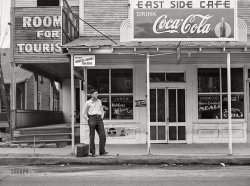
- Filigree: 1937
- ... the tourist trade by Helen Pitkin Schertz, "Legends of Louisiana," published by the New Orleans Journal. A photo of the mansion in ... Posted by Dave - 07/19/2012 - 4:36pm -
